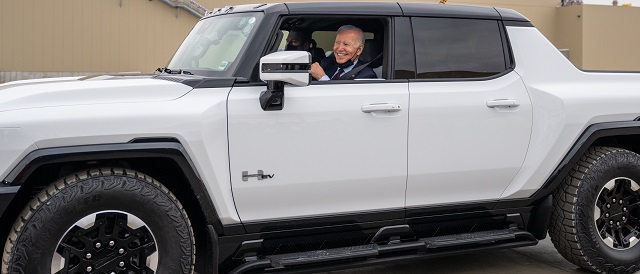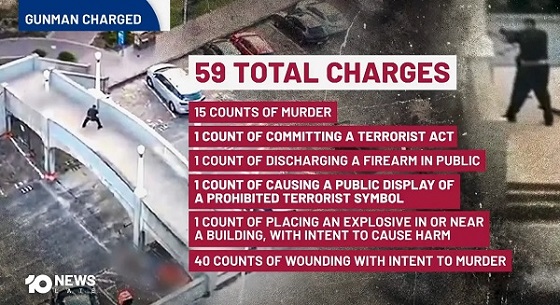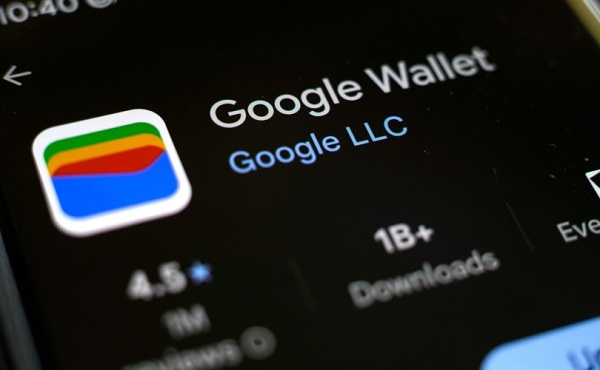Opinion
Biden Promised To Build Half A Million EV Charging Stations. So far, There Are A Grand Total Of 8.

 From the Daily Caller News Foundation
From the Daily Caller News Foundation
The Biden administration has spent tens of billions of dollars on green energy and yet last year the U.S. and the world used record amounts of fossil fuels.
That would seem to be prima facie evidence that this “great transition” to renewable energy has so far been an expensive policy belly flop.
The evidence is everywhere. Americans aren’t buying EVs anymore than they were before Biden was elected. The car companies even with record federal subsidies are losing billions of dollars making EVs that people don’t want. Wind and solar still account for less than 15% of American energy, and across the country hundreds of communities are saying “not in my backyard” to ugly and spacious solar and wind farms. And of course gas prices at the pump and electric bills are 30% to 50% higher, even though we were promised that the green revolution would save us money.
A case in point is the scandalous mismanagement of how these green energy programs are being implemented. Consider the $7.5 billion federal program stuck inside the Biden 2021 Infrastructure bill — a law that Biden touts as one of his great achievements. That bill promised half a million EV charging stations installed all over the country.
Instead, there have been a grand total of… drum roll please…”seven or eight installed.” To be fair, that was through last month. They might be up to nine now.
When Transportation Secretary Pete Buttigieg was confronted recently on CBS’s “Face the Nation” about what happened with all the money, he hemmed and hawed and replied: “In order to do a charger, it’s more than just plunking a small device into the ground, there’s utility work, and this is also, really, a new category of federal investment.”
Uh huh! Sure. Installing an electric charger for a Tesla in your garage is very complicated business. It’s like trying to Build the Taj Mahal (which may not have cost $7.5 billion).
Here’s another mystery. Why can’t Pete give us an exact count on the progress when the number is small enough to use his fingers? What is for sure is that at this pace they may get 500 built by 2030 — not the 500,000 promised.
Thank God our celebrated transportation secretary renowned for riding his bike to his office in Washington wasn’t in charge of the Normandy landing.
Then there is the question of where the $7.5 billion of taxpayer money has actually gone. At their current rate of production the final program’s price tag could inflate to more than $1 trillion.
If Trump were president, he’d have long ago summoned Mayor Pete to the Oval Office and greet him with those two words that made him famous: “YOU’RE FIRED.”
Instead many Democrats are quietly talking about throwing Joe Biden off the ticket and one of the front runners to take his place is none other than the highly accomplished Pete Buttigieg.
But there are some serious lessons to be learned from this monumental screw-up.
First, though Biden loves to chat up how much money the government is “investing” — where are the signs that any of these trillions of dollars of borrowed money have improved our lives. This EV charger scandal is just another reminder that the government generally doesn’t “invest” tax dollars — it mostly wastes them.
Second, competence matters. At the Committee to Unleash Prosperity we released a study finding that more than 90% of the Biden top economic and finance team has NO experience running a business. We have an energy secretary who knows nothing about energy and a transportation secretary who knows nothing about transportation. They are either lawyers, academics, politicians or government employees.
They are not bad people. They just don’t know how to run anything — and it shows.
Finally, why do we need the government to build EV charging stations? One hundred years ago the government didn’t build gas stations. They just magically sprouted up all over the roads that crisscross America because entrepreneurs responded to the demand. So two or three brothers would scrap together some cash, buy a small plot of land on I-66, build a service station with four to eight hoses connected to a tank, put up a tall sign posting the gas price and drivers would pull in and fill er up.
All of this “infrastructure” without a single penny or instruction manual from Washington.
Can you imagine if Biden had been president in the 1920s and proclaimed that the government will build 500,000 gas stations? They still wouldn’t be built and we’d all be waiting in long gas lines.
Stephen Moore is a visiting fellow at the Heritage Foundation and a co-founder of the Committee to Unleash Prosperity.
Crime
The Uncomfortable Demographics of Islamist Bloodshed—and Why “Islamophobia” Deflection Increases the Threat


Addressing realities directly is the only path toward protecting communities, confronting extremism, and preventing further loss of life, Canadian national security expert argues.
After attacks by Islamic extremists, a familiar pattern follows. Debate erupts. Commentary and interviews flood the media. Op-eds, narratives, talking points, and competing interpretations proliferate in the immediate aftermath of bloodshed. The brief interval since the Bondi beach attack is no exception.
Many of these responses condemn the violence and call for solidarity between Muslims and non-Muslims, as well as for broader societal unity. Their core message is commendable, and I support it: extremist violence is horrific, societies must stand united, and communities most commonly targeted by Islamic extremists—Jews, Christians, non-Muslim minorities, and moderate Muslims—deserve to live in safety and be protected.
Yet many of these info-space engagements miss the mark or cater to a narrow audience of wonks. A recurring concern is that, at some point, many of these engagements suggest, infer, or outright insinuate that non-Muslims, or predominantly non-Muslim societies, are somehow expected or obligated to interpret these attacks through an Islamic or Muslim-impact lens. This framing is frequently reinforced by a familiar “not a true Muslim” narrative regarding the perpetrators, alongside warnings about the risks of Islamophobia.
These misaligned expectations collide with a number of uncomfortable but unavoidable truths. Extremist groups such as ISIS, Al-Qaeda, Hamas, Hezbollah, and decentralized attackers with no formal affiliations have repeatedly and explicitly justified their violence through interpretations of Islamic texts and Islamic history. While most Muslims reject these interpretations, it remains equally true that large, dynamic groups of Muslims worldwide do not—and that these groups are well prepared to, and regularly do, use violence to advance their version of Islam.
Islamic extremist movements do not, and did not, emerge in a vacuum. They draw from the broader Islamic context. This fact is observable, persistent, and cannot be wished or washed away, no matter how hard some may try or many may wish otherwise.
Given this reality, it follows that for most non-Muslims—many of whom do not have detailed knowledge of Islam, its internal theological debates, historical divisions, or political evolution—and for a considerable number of Muslims as well, Islamic extremist violence is perceived as connected to Islam as it manifests globally. This perception persists regardless of nuance, disclaimers, or internal distinctions within the faith and among its followers.
THE COST OF DENIAL AND DEFLECTION
Denying or deflecting from these observable connections prevents society from addressing the central issues following an Islamic extremist attack in a Western country: the fatalities and injuries, how the violence is perceived and experienced by surviving victims, how it is experienced and understood by the majority non-Muslim population, how it is interpreted by non-Muslim governments responsible for public safety, and how it is received by allied nations. Worse, refusing to confront these difficult truths—or branding legitimate concerns as Islamophobia—creates a vacuum, one readily filled by extremist voices and adversarial actors eager to poison and pollute the discussion.
Following such attacks, in addition to thinking first of the direct victims, I sympathize with my Muslim family, friends, colleagues, moderate Muslims worldwide, and Muslim victims of Islamic extremism, particularly given that anti-Muslim bigotry is a real problem they face. For Muslim victims of Islamic extremism, that bigotry constitutes a second blow they must endure. Personal sympathy, however, does not translate into an obligation to center Muslim communal concerns when they were not the targets of the attack. Nor does it impose a public obligation or override how societies can, do, or should process and respond to violence directed at them by Islamic extremists.
As it applies to the general public in Western nations, the principle is simple: there should be no expectation that non-Muslims consider Islam, inter-Islamic identity conflicts, internal theological disputes, or the broader impact on the global Muslim community, when responding to attacks carried out by Islamic extremists. That is, unless Muslims were the victims, in which case some consideration is appropriate.
Quite bluntly, non-Muslims are not required to do so and are entitled to reject and push back against any suggestion that they must or should. Pointedly, they are not Muslims, a fact far too many now seem to overlook.
The arguments presented here will be uncomfortable for many and will likely provoke polarizing discussion. Nonetheless, they articulate an important, human-centered position regarding how Islamic extremist attacks in Western nations are commonly interpreted and understood by non-Muslim majority populations.
Non-Muslims are free to give no consideration to Muslim interests at any time, particularly following an Islamic extremist attack against non-Muslims in a non-Muslim country. The sole exception is that governments retain an obligation to ensure the safety and protection of their Muslim citizens, who face real and heightened threats during these periods. This does not suggest that non-Muslims cannot consider Muslim community members; it simply affirms that they are under no obligation to do so.
The impulse for Muslims to distance moderate Muslims and Islam from extremist attacks—such as the targeting of Jews in Australia or foiled Christmas market plots in Poland and Germany—is understandable.
Muslims do so to protect their own interests, the interests of fellow Muslims, and the reputation of Islam itself. Yet this impulse frequently collapses into the “No True Scotsman” fallacy, pointing to peaceful Muslims as the baseline while asserting that the attackers were not “true Muslims.”
Such claims oversimplify the reality of Islam as it manifests globally and fail to address the legitimate political and social consequences that follow Islamic extremist attacks in predominantly non-Muslim Western societies. These deflections frequently produce unintended effects, such as strengthening anti-Muslim extremist sentiments and movements and undermining efforts to diminish them.
The central issue for public discourse after an Islamic extremist attack is not debating whether the perpetrators were “true” or “false” Muslims, nor assessing downstream impacts on Muslim communities—unless they were the targets.
It is a societal effort to understand why radical ideologies continue to emerge from varying—yet often overlapping—interpretations of Islam, how political struggles within the Muslim world contribute to these ideologies, and how non-Muslim-majority Western countries can realistically and effectively confront and mitigate threats related to Islamic extremism before the next attack occurs and more non-Muslim and Muslim lives are lost.
Addressing these realities directly is the only path toward protecting communities, confronting extremism, and preventing further loss of life.
Ian Bradbury, a global security specialist with over 25 years experience, transitioned from Defence and NatSec roles to found Terra Nova Strategic Management (2009) and 1NAEF (2014). A TEDx, UN, NATO, and Parliament speaker, he focuses on terrorism, hybrid warfare, conflict aid, stability operations, and geo-strategy.
The Bureau is a reader-supported publication.
To receive new posts and support my work, consider becoming a free or paid subscriber.
International
Bondi Beach Shows Why Self-Defense Is a Vital Right

By
Individuals and communities must take responsibility for their own safety.
|
||||||||||||||||||||||||||||||||||||||||||||||||||
|
|
||||||||||||||||||||||||||||||||||||||||||||||||||
|
||||||||||||||||||||||||||||||||||||||||||||||||||
|
||||||||||||||||||||||||||||||||||||||||||||||||||
|
||||||||||||||||||||||||||||||||||||||||||||||||||
|
||||||||||||||||||||||||||||||||||||||||||||||||||
|
||||||||||||||||||||||||||||||||||||||||||||||||||
|
||||||||||||||||||||||||||||||||||||||||||||||||||
|
||||||||||||||||||||||||||||||||||||||||||||||||||
|
||||||||||||||||||||||||||||||||||||||||||||||||||
|
||||||||||||||||||||||||||||||||||||||||||||||||||
|
||||||||||||||||||||||||||||||||||||||||||||||||||
-

 Digital ID2 days ago
Digital ID2 days agoCanada releases new digital ID app for personal documents despite privacy concerns
-

 Energy2 days ago
Energy2 days agoCanada’s sudden rediscovery of energy ambition has been greeted with a familiar charge: hypocrisy
-

 Bruce Dowbiggin2 days ago
Bruce Dowbiggin2 days agoNFL Ice Bowls Turn Down The Thermostat on Climate Change Hysteria
-

 Energy2 days ago
Energy2 days agoCan we not be hysterical about AI and energy usage?
-

 Energy2 days ago
Energy2 days agoEnergy security matters more than political rhetoric
-

 Daily Caller18 hours ago
Daily Caller18 hours agoParis Climate Deal Now Decade-Old Disaster
-

 Business8 hours ago
Business8 hours agoOttawa Pretends To Pivot But Keeps Spending Like Trudeau
-

 armed forces1 day ago
armed forces1 day agoOttawa’s Newly Released Defence Plan Crosses a Dangerous Line











